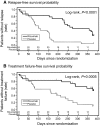Rituximab for nephrotic syndrome in children
- PMID: 27422620
- PMCID: PMC5388729
- DOI: 10.1007/s10157-016-1313-5
Rituximab for nephrotic syndrome in children
Abstract
Idiopathic nephrotic syndrome is the most common chronic glomerular disease in children. At least 20 % of children with this syndrome show frequent relapses and/or steroid dependence during or after immunosuppressive therapies, a condition defined as complicated frequently relapsing/steroid-dependent nephrotic syndrome (FRNS/SDNS). Approximately 1-3 % of children with idiopathic nephrotic syndrome are resistant to steroids and all immunosuppressive agents, a condition defined as refractory steroid-resistant nephrotic syndrome (SRNS); these SRNS children have a high risk of end-stage renal failure. Rituximab, a chimeric anti-CD20 monoclonal antibody, has been shown to be effective for patients with complicated FRNS/SDNS and refractory SRNS. This review describes the recent results of rituximab treatment applied to pediatric nephrotic syndrome, as well as those of our recent study, a multicenter, double-blind, randomized, placebo-controlled trial of rituximab for childhood-onset complicated FRNS/SDNS (RCRNS01). The overall efficacy and safety of rituximab for this disease are discussed.
Keywords: Children; Complicated frequently relapsing/steroid-dependent nephrotic syndrome; Idiopathic nephrotic syndrome; Proteinuria; Rituximab.
Conflict of interest statement
Conflict of interest
Kazumoto Iijima has received Grants from Japan Agency for Medical Research and Development (16lk0201021h0004), and from Japan Medical Association Center for Clinical Trials (CCT-B-2001), personal fees for Safety Review Committee and lecture from Zenyaku Kogyo Co., Ltd., and lecture and manuscript fees from Chugai Pharmaceutical Co., Ltd., during the conduct of the study. KI has also has received grants from Novartis Pharma K.K., Japan Blood Product Organization, Pfizer Japan, Inc., Kyowa Hakko Kirin Co., Ltd., AbbVie LLC, JCR Pharmaceuticals Co., Ltd., Daiichi Sankyo, Co., Ltd., Genzyme Japan K.K., Teijin Pharma Ltd., Miyarisan Pharmaceutical Co., Ltd., CSL Behring, Novo Nordisk Pharma Ltd., AIR WATER MEDICAL Inc., and Astellas Pharma Inc., Lecture fees from Pfizer Japan, Inc., Asahi Kasei Pharma Corp., Kowa Pharmaceutical Co., Ltd., MSD, ALEXION Pharmaceuticals, AstraZeneca K.K., Meiji Seika Pharma Co., Ltd., Novartis Pharma K.K., Daiichi Sankyo, Co., Ltd., Springer Japan, Medical Review Co. Ltd., Boehringer Ingelheim, and NIKKEI RADIO BROADCASTING CORPORATION, and consulting fees from Astellas Pharma Inc., ONO PHARMACEUTICAL CO., LTD. and Takeda Pharmaceutical Company Limited, outside the submitted work. Mayumi Sako has received personal fees for Safety Review Committee and lecture from Zenyaku Kogyo Co., Ltd. during the conduct of the study. Kandai Nozu has received lecture fees from Taisho Pharma and Novartis Pharma outside the submitted work.
Figures



References
-
- International Study of Kidney Disease in Children Nephrotic syndrome in children: prediction of histopathology from clinical and laboratory characteristics at time of diagnosis. A report of the International Study of Kidney Disease in Children. Kidney Int. 1978;13:159–165. doi: 10.1038/ki.1978.23. - DOI - PubMed
-
- Hodson EM, Willis NS, Craig JC. Non-corticosteroid treatment for nephrotic syndrome in children. Cochrane Database Syst Rev. 2013. Art. No. CD002290, Issue 10. doi:10.1002/14651858.CD002290.pub4. - PubMed
-
- Hodson EM, Willis NS, Craig JC. Interventions for idiopathic steroid-resistant nephrotic syndrome in children. Cochrane Database Syst Rev 2010. Art. No. CD003594, Issue 11. doi:10.1002/14651858.CD003594.pub4. - PubMed
Publication types
MeSH terms
Substances
Supplementary concepts
LinkOut - more resources
Full Text Sources
Other Literature Sources
Medical

